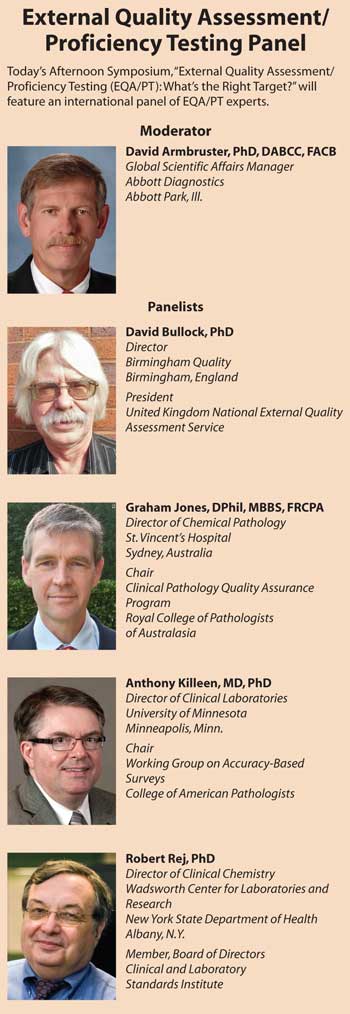
Proficiency testing is a regulatory requirement, but it also provides clinical laboratories an opportunity to dynamically assess and improve quality, ultimately enhancing patient care and safety. The latter point will be an emphasis of today's afternoon symposium, "External Quality Assessment/Proficiency Testing (PT/EQA): What's the Right Target?" taking place from 2:30–5:00 p.m. in Room 408A of the Los Angeles Convention Cenater.
"One of the themes will be that although proficiency testing is a requirement for clinical laboratories in the U.S. and many other countries, an important question for laboratorians to ask is: am I simply doing this to satisfy a regulatory requirement or should I be doing it in order to increase the quality of my services?" explained symposium moderator, David Armbruster, PhD, DABCC, FACB, global scientific affairs manager at Abbott Diagnostics. "That plays out in the choice of surveys. If a lab enrolls in a survey that's easy to pass because it's not too restrictive and has wide limits but enables the lab to meet regulatory requirements, that's one approach. However, laboratorians also could ask themselves whether they should participate in a more demanding survey to ensure they're really doing the best they can in terms of accuracy and thus patient care and safety."
Those opposing considerations will be brought out when the symposium's four panelists discuss their respective PT/EQA survey processes. Anthony Killeen, MD, PhD, chair of the College of American Pathologists' (CAP) working group on accuracy-based surveys, will review CAP's PT programs, while Robert Rej, PhD, will provide an overview of the New York State Department of Health's Clinical Laboratory Evaluation Program. Rej, who is director of clinical chemistry at the Department's Wadsworth Center for Laboratories and Research, also serves on the board of directors of the Clinical and Laboratory Standards Institute, which is cosponsoring the symposium with AACC's Industry Division.
The overview of PT/EQA programs will have an international flair as well. David Bullock, PhD, director of Birmingham Quality in Birmingham, England, and president of the United Kingdom National External Quality Assessment Service (UK NEQAS), will describe that program, while Graham Jones, DPhil, MBBS, FRCPA, will discuss the Royal College of Pathologists of Australasia (RCPA) EQA Program. Jones is director of chemical pathology at St. Vincent's Hospital in Sydney, Australia. Though based in and primarily serving labs from particular countries, the various programs have multi-national participants.

Towards Accuracy-Based PT
In addition to discussing the nuances of their programs, the panelists also are expected to emphasize that the field of PT/EQA is evolving. Traditionally, PT/EQA programs have required labs to test samples of known concentrations of various analytes, with an expectation for most measurands that 95% of labs will report results within about two standard deviations of the analyte concentration in question. Lab performance is evaluated within the context of peer groups based on the analysis method or instrument used. However, in an effort to raise the quality bar, PT/EQA programs, including all the ones which will be represented at today's symposium, have introduced accuracy-based grading for at least some analytes. This involves assessing how close participating labs come to reporting the true value of the measurand in question based on a target value assigned by a reference method. Labs that return a value more than a fixed number from the true value receive an unsatisfactory grade.
"It's important that the results not just be consistent, say within a peer group using the same assay, but that they actually be accurate to within a specified degree," explained Armbruster. "This accuracy-based approach ensures that the results are compared not only within peer groups but also within all peer groups to what is the scientifically correct answer as determined by a reference method. The purpose is to ensure comparability, and harmonization, or ideally even standardization, of assays throughout all labs."
HbA1c: A Boost in Test Performance
HbA1c and creatinine are examples of analytes for which PT/EQA programs have moved to accuracy-based grading. In the case of HbA1c, the impetus for the change came from both laboratorians and the endocrinology community, Armbruster recalled. "Clinicians indicated that they needed more accurate results, because not only are we monitoring diabetics and how tight their glycemic control is, but as of a couple of years ago we started using HbA1c results to screen for and make a diagnosis of diabetes. So before any patients is falsely diagnosed as diabetic, we needed to improve the performance of assays, and the way we can do that is through EQA and PT testing," he said.
In consonance with standardization goals set by the National Glycohemoglobin Standardization Program, CAP and other PT/EQA programs initiated accuracy-based surveys which require labs to measure samples tied to reference method determinations of the true value, within ever-tightening performance goals. This has had the intended effect, according to Armbruster. "The CAP program has data demonstrating that performance has vastly improved over the years. A few years ago the passing score for HbA1c was the target value plus or minus 15 percent and over the years, it's decreased until as of last year, when it was down to plus or minus seven percent."
Armbruster emphasized that the move towards accuracy-based PT/EQA is even more relevant today with widespread adoption of electronic health records. "Comparability of results is a key issue in this day and age with electronic health records. This is a great idea, that in an electronic file you can capture a patient's medical history, which of course includes laboratory data. The problem is, if more than one lab is testing samples from a patient and the results they produce are not comparable, the physician will have a hard time interpreting those results in the electronic health record if they're inconsistent or don't reflect an actual clinical change in a patient's condition," he observed.
Labs interested in going beyond the basics of PT/EQA should carefully consider the surveys they enroll in, Armbruster advised. "Laboratories have the chance to pick and choose from many different offerings from the QA/PT providers and can customize their choices so they can make a conscious decision about whether they want to check-off a regulatory requirement or whether they really want to challenge themselves with the idea of improving their performance and guaranteeing that they're doing the best job they can for their patients." Attendees at today's symposium will surely come away with plenty of food for thought in that decision process.